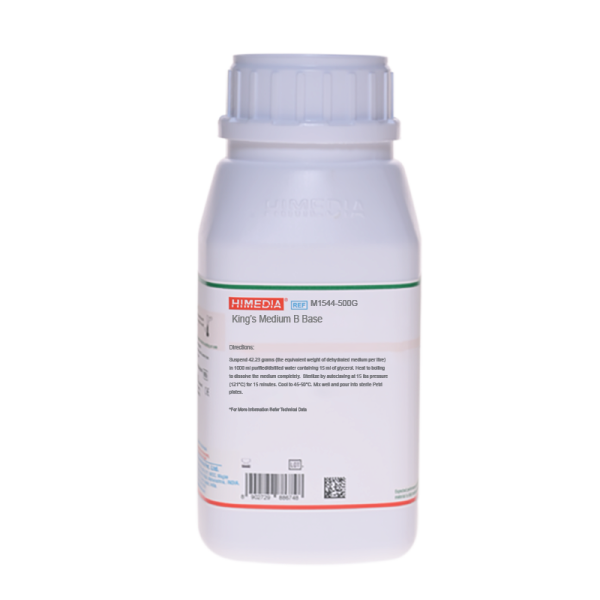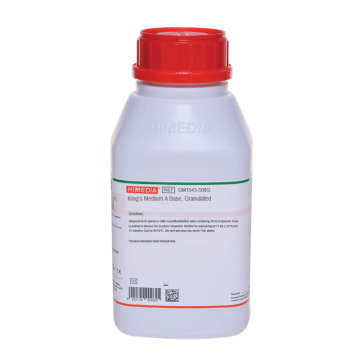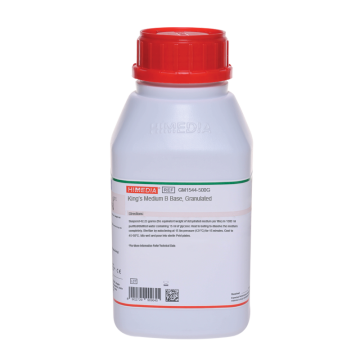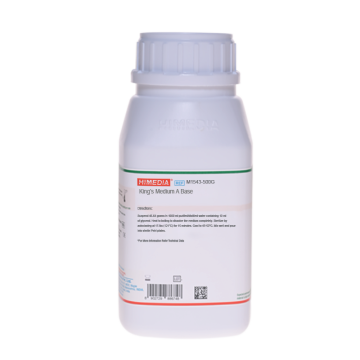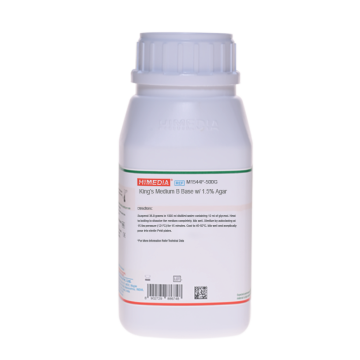 Your enquiry has been submitted
Your enquiry has been submitted
King’s Medium B Base
Kings Medium B Base is recommended for non-selective isolation, cultivation and pigment production of Pseudomonas species.
Composition**
| Ingredients | Gms / Litre |
|---|---|
| Proteose peptone | 20.000 |
| Dipotassium hydrogen phosphate | 1.500 |
| Magnesium sulphate heptahydrate | 1.500 |
| Agar | 20.000 |
Final pH (at 25°C): 7.2±0.2
**Formula adjusted, standardized to suit performance parameters
Directions
Suspend 42.23 grams of dehydrated medium in 1000 ml distilled water containing 15 ml of glycerol. Heat to boiling to dissolve the medium completely. Mix well. Sterilize by autoclaving at 15 lbs pressure (121°C) for 15 minutes. Aseptically pour into sterile Petri plates.
Principle And Interpretation
Pseudomonas aeruginosa is known to produce two types of pigments, pyocyanin and fluorescein which is a characteristic property and aids in isolation of Pseudomonas from clinical material. An additional pigment called as pyorubin was reported by King. Pyocyanin is green while fluorescein is fluorescent yellow and pyorubin is reddish brown. Some strains produce all these pigments while the others produce one or two pigments. P. aeruginosa can be identified on Hugh Leifson Medium (M826). Kings Medium B Base is particularly suited for fluorescein.
Kings Medium B Base is based on the formulation of King et al (1,2). This medium can be used as a general medium for the non-selective isolation and pigment production of Pseudomonas species from foods, cosmetic samples etc. Agrobacterium have been traditionally identified as gram-negative bacteria that do not produce fluorescent pigment on Kings B medium and do produce tumors (or hairy roots) when inoculated onto test plants (3).
These media contain proteose peptone, which provides carbonaceous and nitrogenous compounds for the growth of bacteria. Glycerol serves as a source of energy and also enhances pigment production. Magnesium sulphate also enhances pigment production. Pigments and/ or their derivatives produced by Pseudomonas species play a role as siderophores in the iron uptake systems of bacteria, and hence, their production is markedly enhanced under conditions of iron deficiency. The production of pigments especially non-fluorescent blue pigment, pyocyanin is readily demonstrated by culturing on Kings Medium B, which contains no added iron (4). The addition of dipotassium phosphate increases the phosphorus content of the medium thereby enhancing production of fluorescent pigment. For inoculation, use the organisms freshly cultured in Kings Medium A, incubate overnight at 37°C and then at room temperature for 6 days. With Kings Medium B, incubate at 37°C for 6 days.
Quality Control
Appearance Cream to yellow homogeneous free flowing powder
Gelling Firm, comparable with 2.0% Agar gel
Colour and Clarity of prepared medium Light yellow coloured, clear to slightly opalescent gel forms in Petri plates
Reaction Reaction of 4.22% w/v aqueous solution (containing 1.5%v/v glycerol) at 25°C. pH : 7.2±0.2
pH 7.00-7.40
Cultural Response
M1544: Cultural characteristics observed after an incubation at 35-37°C for 18-24 hours.
| Organism | Inoculum (CFU) | Growth | Recovery | Pigment production |
|---|---|---|---|---|
| Pseudomonas aeruginosa ATCC 17934 | 50-100 | good-luxuriant | >=70% | greenish yellow |
| Pseudomonas aeruginosa ATCC 27853 | 50-100 | good-luxuriant | >=70% | greenish yellow |
| Pseudomonas aeruginosa ATCC 9027 | 50-100 | good-luxuriant | >=70% | greenish yellow |
| Burkholderia cepacia ATCC 25609 | 50-100 | good-luxuriant | >=70% | no pigment |
Storage and Shelf Life
Store below 30°C in tightly closed container and prepared medium at 2-8°C. Use before expiry period on the label.
Reference
- King E. O., Ward M. K. and Raney D. E., 1954, J. Lab and Clin. Med., 44:301-307.
- Murray P. R., Baron E. J., Jorgensen J. H., Pfaller M. A., Yolken R. H., (Eds.), 8th Ed., 2003, Manual of Clinical Microbiology, ASM, Washington, D.C.
- Ann G., Matthysse, 1998, The Genus Agraobacterium, Chapter 3.1.4. Martin Dworkin, 3rd Ed., The Prokaryotes, An Evolving Electronic Resource for the Micrbiological Community.
- Todar K., Todars Online Textbook of Bacteriology, University of Wisconsin - Madison, Department of Bacteriology.
| Product Name | King’s Medium B Base |
|---|---|
| SKU | M1544 |
| Product Type | Regular |
| Physical Form | Powder |
| Origin | Animal |
| Packaging type | HDPE |
| References | 1. Ann G., Matthysse, 1998, The Genus Agraobacterium, Chapter 3.1. |
| Customized Product Available | No |



